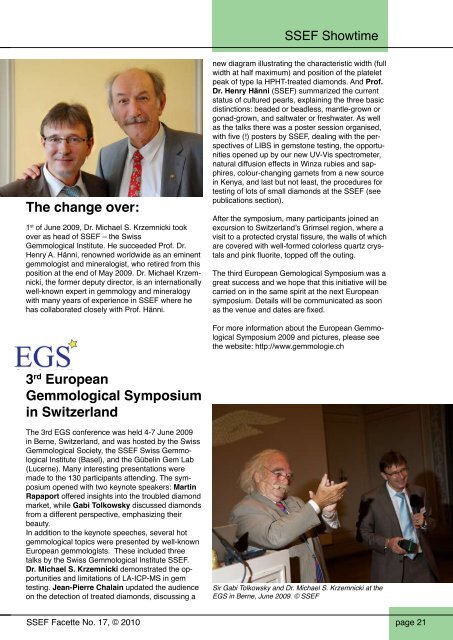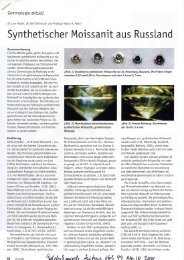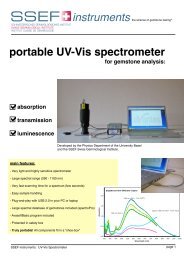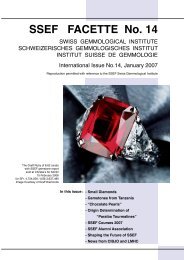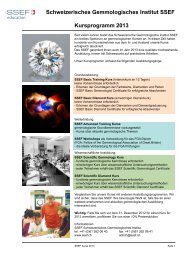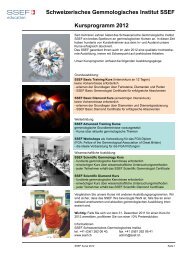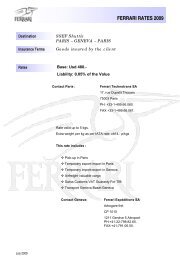SSEF FACETTE No. 17
SSEF FACETTE No. 17
SSEF FACETTE No. 17
You also want an ePaper? Increase the reach of your titles
YUMPU automatically turns print PDFs into web optimized ePapers that Google loves.
The change over:<br />
1 st of June 2009, Dr. Michael S. Krzemnicki took<br />
over as head of <strong>SSEF</strong> – the Swiss<br />
Gemmological Institute. He succeeded Prof. Dr.<br />
Henry A. Hänni, renowned worldwide as an eminent<br />
gemmologist and mineralogist, who retired from this<br />
position at the end of May 2009. Dr. Michael Krzemnicki,<br />
the former deputy director, is an internationally<br />
well-known expert in gemmology and mineralogy<br />
with many years of experience in <strong>SSEF</strong> where he<br />
has collaborated closely with Prof. Hänni.<br />
3 rd European<br />
Gemmological Symposium<br />
in Switzerland<br />
The 3rd EGS conference was held 4-7 June 2009<br />
in Berne, Switzerland, and was hosted by the Swiss<br />
Gemmological Society, the <strong>SSEF</strong> Swiss Gemmological<br />
Institute (Basel), and the Gübelin Gem Lab<br />
(Lucerne). Many interesting presentations were<br />
made to the 130 participants attending. The symposium<br />
opened with two keynote speakers: Martin<br />
Rapaport offered insights into the troubled diamond<br />
market, while Gabi Tolkowsky discussed diamonds<br />
from a different perspective, emphasizing their<br />
beauty.<br />
In addition to the keynote speeches, several hot<br />
gemmological topics were presented by well-known<br />
European gemmologists. These included three<br />
talks by the Swiss Gemmological Institute <strong>SSEF</strong>.<br />
Dr. Michael S. Krzemnicki demonstrated the opportunities<br />
and limitations of LA-ICP-MS in gem<br />
testing. Jean-Pierre Chalain updated the audience<br />
on the detection of treated diamonds, discussing a<br />
<strong>SSEF</strong> Facette <strong>No</strong>. <strong>17</strong>, © 2010<br />
<strong>SSEF</strong> Showtime<br />
new diagram illustrating the characteristic width (full<br />
width at half maximum) and position of the platelet<br />
peak of type Ia HPHT-treated diamonds. And Prof.<br />
Dr. Henry Hänni (<strong>SSEF</strong>) summarized the current<br />
status of cultured pearls, explaining the three basic<br />
distinctions: beaded or beadless, mantle-grown or<br />
gonad-grown, and saltwater or freshwater. As well<br />
as the talks there was a poster session organised,<br />
with five (!) posters by <strong>SSEF</strong>, dealing with the perspectives<br />
of LIBS in gemstone testing, the opportunities<br />
opened up by our new UV-Vis spectrometer,<br />
natural diffusion effects in Winza rubies and sapphires,<br />
colour-changing garnets from a new source<br />
in Kenya, and last but not least, the procedures for<br />
testing of lots of small diamonds at the <strong>SSEF</strong> (see<br />
publications section).<br />
After the symposium, many participants joined an<br />
excursion to Switzerland’s Grimsel region, where a<br />
visit to a protected crystal fissure, the walls of which<br />
are covered with well-formed colorless quartz crystals<br />
and pink fluorite, topped off the outing.<br />
The third European Gemological Symposium was a<br />
great success and we hope that this initiative will be<br />
carried on in the same spirit at the next European<br />
symposium. Details will be communicated as soon<br />
as the venue and dates are fixed.<br />
For more information about the European Gemmological<br />
Symposium 2009 and pictures, please see<br />
the website: http://www.gemmologie.ch<br />
Sir Gabi Tolkowsky and Dr. Michael S. Krzemnicki at the<br />
EGS in Berne, June 2009. © <strong>SSEF</strong><br />
page 21


